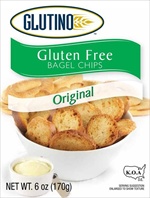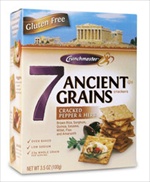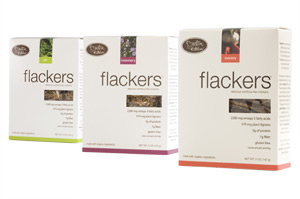Glutino Bagel Chips are now available in Original and Parmesan Garlic flavor. These bite size gluten free bagel chips are perfect for snacking and dipping.

Glutino Bagel Chips are now available in Original and Parmesan Garlic flavor. These bite size gluten free bagel chips are perfect for snacking and dipping.

Crunchmaster 7 Ancient Grains Crackers are now available in Hint of Sea Salt and Cracked Pepper & Herb flavors. These crunchy crackers are low calorie and gluten free. Perfect for dips or spreads.

Walden Farms has given Linda’s Diet Delites the privelage of being one of the very first stores to offer customers all the new flavors of Miracle Mayo. No longer limited to plain old mayo, you can now also choose from Ranch Mayo, Pomegranate Mayo, Chipotle Mayo, and Honey Mustard Mayo. All mayo flavors are still zero calories, zero fat, zero carbs, and zero sugar.

Whether you eat a gluten free diet because you suffer from Celiac disease or are just one of the millions of Americans who suffer the side effects of being intolerant to wheat, eating out can be a minefield.
Gluten free dieters have even more of a difficult job than low carb dieters when it comes to dining out, because wheat is used in so many food products, to thicken, flavor and stabilize food. Celiacs also have the added issue of cross contamination to contend with so have to be extra careful when it comes to dining out.
Thankfully the catering world is fast becoming more aware of Celiacs and is starting to label their menus and products a lot better and train their staff to be aware of the needs of Celiacs, but it’s not always easy to spot foods that may contain gluten.
Do Your Homework
Make sure that you’re aware of the types of food products and meals which may contain gluten. Also be aware of foods that could have been cross-contaminated with gluten – ie fries that have been cooked in the same oil as breaded products. Most sauces unless labelled as ‘gluten free’ will probably have been thickened using some wheat product so it’s usually wise to give these a wide berth.
Stick with foods you know won’t contain gluten – un-breaded meat and fish, potatoes, vegetables, rice and salad without dressing or croutons are usually safe bets. If in doubt ask your server to check with the chef.
Ask Around
Local Celiac groups and internet forums will be a great place to find celiac-friendly restaurants. Don’t forget to spread the word yourself when you come across an eatery that caters for your needs.
Reseach Your Restaurant
Ring a restaurant up in advance to ensure that they can cater for your needs, or ask them to email you a copy of their menu so you make sure you can order something you know will be gluten free.
If you’re planning on going to an Italian restaurant – why not ring and ask if they’ll prepare some gluten free pasta for you, or take your own for them to cook along with one of their fresh sauces.
Know Which Questions to Ask
If you are in any doubt as to whether a menu item may contain gluten you’ll need to get your server to check with the chef. Here’s a list of questions to ask that will ensure that you don’t accidentally consume any gluten.
Does the Salad come with croutons? Can they be left off?
What is in the Salad Dressing?
Is the soup home-made or canned – if canned, ask to see a can so you can read the label
Has the fish or meat been marinated – if so, what in?
Has anything been dusted with flour?
Are the French Fries cooked in the same oil as breaded products?
Do you use imitation crabmeat or seafood?
Does the ice cream come with a wafer or cookie?
Are the mash potatoes made from scratch or from a mix?
Can this meal be served without the sauce?
Accept That You May Have to eat a Fairly Bland Meal
Sometime the best option will be to get the chef to prepare a piece of plain meat or fish with some side vegetables and potatoes. It won’t necessarily be the greatest culinary experience you’ll have, but it will ensure that you have a good night out with your friends or family and not have to worry about getting ill.
NoOodle Noodles are now available. Zero calories, zero net carb noodles created from yam flour and a touch of lime.

There is much talk of diets such as gluten-free or lactose-free. Sometimes people undertake these diets for weight loss purposes, but for many people they have to eat gluten-free or lactose-free because they have food intolerance.
What Are Food Intolerances?
Food intolerances are generally where a person has adverse reactions to a particular food or food group. Usually, the reaction happens every each time the food has been consumed and the more the food is eaten the worse the reactions.
Food intolerances are not to be confused with food allergies, whilst food intolerances can make life pretty miserable to the sufferer they are in no way life-threatening. Food allergies on the other hand can cause major health issues such as anaphylactic shock which could result in death, so the sufferer needs to take great care not to accidentally consume the offending food.
What Causes Food Intolerances?
Usually a food intolerance occurs because the body is unable to produce enough of an enzyme (or chemical reaction) to break down that food in the digestive system. For instance, a lot of people have an intolerance to lactose, which is the natural sugar found in cow’s milk. Those who have a lactose intolerance have a shortage of an enzyme called lactase in their small intestine, because of this shortage they are unable to break down the lactose so that it can be absorbed correctly into the bloodstream.
The body’s inability to deal with certain foods causes the sufferer many side effects which may occur immediately or some days after eating the food.
What are the Most Common Food Intolerances?
The most common food intolerances are lactose and wheat (or gluten), but there are other foods groups such as soy, fructose, yeast, and nightshade vegetables (peppers—chilli and bell, eggplants, potatoes, tomatoes) that many people also have a high sensitivity towards.
Who’s Affected by Food Intolerances?
It’s estimated that between 30 and 50 million people in the USA are lactose intolerant, however most of these won’t realise it. Some 1 in 7 are said to be wheat intolerant.
Babies generally have higher levels of lactase so most lactose intolerances don’t surface until over 2 years of age. Some races are more predisposed to be lactose intolerant than others, for example American and Northern Europeans have a 10%-15% affliction rate, whereas the Asian, African and native American races have between 70% and 90%.
What are the Symptoms of Food Intolerance?
There are many symptoms of food intolerance, thankfully whilst they are uncomfortable for the sufferer they are rarely life-threatening. The side effects of eating foods that a person is intolerant to include, bloating, nausea, IBS, diarrhoea, constipation, headaches, lethargy, sinus complaints, skin problems such as eczema and rashes, and mood swings.
The more a food is consumed the worse the symptoms are likely to be.
How to Tell if You Have a Food Intolerance?
The easiest way to find out if you have a food intolerance is to eliminate the food from your diet. If, after a few weeks your symptoms have improved you can then re-introduce the food to see if the negative symptoms return. If they do return it’s likely that you have an intolerance to that particular food.
Bear in mind that it can take a few weeks before you start to feel better, and in some cases you may feel worse, as you go through withdrawal symptoms, before you start to see improvements. Also, it’s common for people to have more than one food intolerance. If you suspect more than one food group is giving you problems then you will need to eliminate them all, and then re-introduce them individually until you find out which are your culprits.
You can also arrange for blood tests and stool tests from your doctor.
How do You Treat a Food Intolerance?
The best way to treat a food intolerance is to completely eliminate it from your diet. Some people can tolerate small amounts of the foods every once in a while without too many problems, but others find that complete avoidance is the only way.
For lactose intolerance lactase enzyme drops or capsules can be prescribed by your medical practitioner.
If you have got a food intolerance you need to ensure that you are making up your vital nutrients, such as fiber and calcium, with other foods. We here at Linda’s Diet Delites stock a range of products that suit wheat and lactose intolerances as they are gluten or lactose free.
Michael Nace is a blogger for Linda’s Diet Delites.
Annie’s Homegrown Gluten Free Bunny Cookies are now available in Snickerdoodle and Ginger Snap to compliment the already available Cocoa and Vanilla.


Better ‘n Peanut Butter Banana style is now available. Add a burst of flavor to your tired peanut butter and have it low in calories too!

Doctor in the Kitchen Flackers low carb flax seed crackers are now available.
From Doctor in the Kitchen, “Flackers are a delicious, health giving, flax seed cracker. The seeds are sprouted to increase the bioavailability of the nutrients then dehydrated at low temperatures to preserve the omega-3 fatty acid. Flax seeds should be part of every optimal health and longevity diet. They are high in alpha linolenic acid – a heart healthy omega-3 fatty acid. They are packed with fiber, which helps to maintain normal cholesterol levels and promote optimal digestion. Also, these powerhouse seeds are filled with antioxidants, protein, plant lignans, and many vitamins and minerals.”

If you’re researching information online about gluten free diets and celiac disease, then be sure to read this article about the potentially harmful effects of one of the most wholesome and basic foods on the planet — wheat.
Wheat is a staple food all over the world, breads of different descriptions, pasta and noodles are all made from wheat and can make up a large part of our daily diets. For a lot of us, however, we often discover that wheat is the cause of much of our health miseries, ranging from celiac disease where sufferers are unable to eat gluten, which is found in many other grains as well as wheat, to a range of symptoms that are not life threatening but can still interfere with our general health and wellbeing.
Whilst a true allergy to wheat is quite rare the affects can be very serious with coughing, eczema, asthma, breathing difficulties and vomiting amongst immediate symptoms. Thankfully, most people suffer from a less serious intolerance to wheat. Intolerance to wheat can make life miserable for sufferers, with side effects such as sinusitis, headaches, skin rashes, hay fever type symptoms, digestive problems, bloating, tiredness and constipation. Eliminating wheat from our diets will see a rapid improvement in these symptoms, but navigating a food world without wheat takes some skill and practice.
Changing Your Eating Habits
If you are used to having toast or bagel for breakfast, grabbing a sandwich at lunch and popping out for pizza or pasta for your evening meal then you are going to have to seriously rethink your diet. Likewise, those who love to bake cakes and cookies at home will have to investigate all the different options available to them to replace their regular flour with wheat-free versions.
Here are some examples of wheat-free flour alternatives, please note that they will not taste exactly the same, nor will they have the same consistency and texture, you will need to experiment to find the products that best suit your needs and personal taste buds.
Alternatives for wheat flour include:
Rice Flour
Garbanzo (chick-pea) Flour
Potato Starch & Potato Flour
Rolled Oats
Tapioca Flour
Arrowroot Flour
Corn Flour & Corn Starch
Cornmeal
Soy Flour
Chestnut Flour
Buckwheat Flour
Quinoa Flour
Rye Flour (not suitable for those on a gluten free diet)
Barley Flour (not suitable for those on a gluten free diet)
For those of us who don’t tend to do much home cooking and baking then thankfully there are many alternative foods that are wheat-free, along with fairly easy ways to change your eating habits. Some simple ideas include choosing breakfast cereals that are rice or oat based instead of wheat, having sandwich fillings or pasta sauces on a baked potato or with fries, eating corn tortillas or nachos instead of bread (although check that the brand doesn’t contain wheat) with your soup.
Gluten-Free Food Products
Because of the increase of celiac disease there is now much better labelling on food stuffs, and there has also been a big rise in the amount of gluten-free foods available. Thankfully you don’t need to be a celiac to take advantage of these products and if you have a wheat intolerance then you will find them most helpful in your quest to become wheat-free. Scouring the internet for gluten-free recipes will also provide you with a host of delicious recipes and cookery ideas along with ways to replace your regular wheat products with non-wheat products.